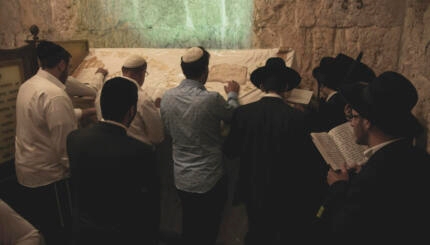Many of the Jewish communities that I research and write about for our Encyclopedia of Southern Jewish Communities are quite small. Very few people are aware that Jews established congregations in places like Lexington, Mississippi, or Owensboro, Kentucky. Finding congregational records or other information about these communities can be a real challenge. Thankfully, I have found a few extremely useful sources at the leading archives of American Jewish history.
The American Jewish Historical Society, whose archives are housed at the Center for Jewish History in New York, owns the records of the Industrial Removal Office. The IRO once helped to relocate poor Jewish immigrants from New York to other cities and towns around the country. The organization’s records are fascinating, but perhaps most useful for me are the surveys they sent out to towns to collect information about the local Jewish community. In 1908, they sent one to Morris Baldauf, one of the leaders of the small Jewish congregation in Henderson, Kentucky. Baldauf took this questionnaire seriously, and gave a precise accounting of the local Jewish population, noting that there were 58 adults and 69 children. He also provided information about the local economy, educational system, and even climate. Such a rich, contemporary description of a Jewish community is the gold standard for us historians.
A few weeks ago, I was able to visit the Jacob Rader Marcus Center of the American Jewish Archives on the campus of Hebrew Union College in Cincinnati. HUC has a long tradition of serving small congregations through its student rabbi program. The correspondence and paperwork related to the program have been preserved at the archives, and they provide a treasure trove of information. A big reason for this was the foresight of Jacob Rader Marcus, the longtime professor of Jewish history at the college and the founder of the archives. Marcus and the leadership of HUC had each rabbinic student who served a congregation fill out of a detailed form about the local Jewish community. Particularly useful was the form from 1935. While some of the questions were straightforward (how many Jews lived there; what the style of worship was), others were clearly those of a historian hoping to help future researchers: when did Jews first arrive; where are the records of the congregation kept; is there a
shochet
or
moil
in town; is there “a distinct cleavage between orthodox and reform Jews”; have Jews ever held elected office in the town; have there been any notable instances of anti-Semitism; are there any intermarried couples and are they raising their children to be Jewish.
Thanks to Dr. Marcus, I was able to use these questionnaires to provide a detailed portrait of several small Jewish communities at a particular point in history. Each year, the student rabbi filled out additional surveys, so I could gauge a congregation’s change over time. For a congregation like Adas Israel in Henderson, Kentucky, which never had more than thirty families and did not produce a long historical record, these documents have proven essential to my writing of its history. In another example, the only way I know that there was once a short-lived congregation in Danville, Kentucky, in the 1940s is through these student rabbi records.
My experience with the IRO Records and the HUC Student Rabbi files got me thinking about the work of our organization, the Institute of Southern Jewish Life. Each weekend our education fellows and rabbi hit the road to serve congregations across the South. After a Monday comp day, they return to the office on Tuesday and write a detailed trip report about their visit. One day, these trip reports will be an amazing source of information about southern Jewish communities in the early years of the 21st century. While history is a record of what happened in the past, it can be both sobering and inspiring to realize that one day we will also be part of history.



